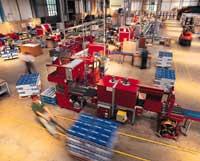Metal Printer
Printers that give the “print” button and make a three-dimensional piece are becoming a common practice in mechanical engineering. Moulds and prototypes for injection processes, extruder hoppers and other devices are already manufactured through this procedure. Speed has become a key factor in industrial processes.The Fraunhofer Institute for Material Research for Engineering and Process Applications of Bremen has prepared the direct printing of metal parts of complex geometry from the data of the CAD program, being the first in Europe. The system is called ProMetal RTS-300.
How does it work?

Once the part is designed by computer, the program stores as three-dimensional data the part to be manufactured. Subsequently, a program called a layer generator divides the part model into overlapping layers and transfers each of them to a printer type device. Using the same principle as conventional injection printers, the printer head launches an adhesive product onto a thin layer of powdered steel. The particles stick and the first layer of the piece is ready. Next, the working tab descends slowly to start working with the second layer. Thus, by layers, the whole piece is manufactured.
The second phase of the process is to give density and resistance to the part. First the excess powder is strange, then the piece is heated to extract the excess adhesive present on the surface and finally the cast bronze is left to filter slowly through the piece to evaporate the adhesive. In the last step standard metal processing techniques are used to give final shape to the part. In this way, the process that covers the weeks and months is achieved in a few days.
Buletina
Bidali zure helbide elektronikoa eta jaso asteroko buletina zure sarrera-ontzian











